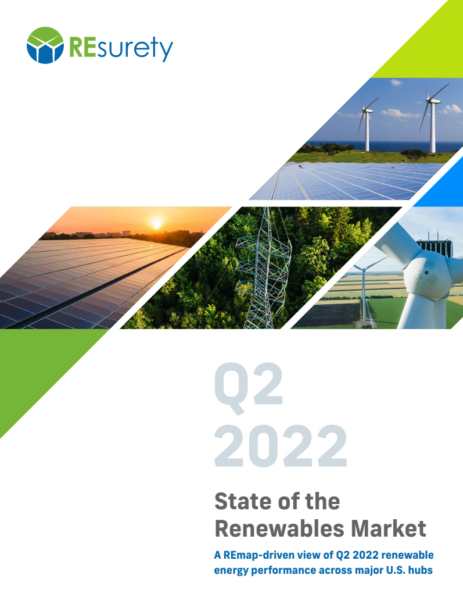August 18, 2022

REsurety creates the REmap-powered State of the Renewables Market report every quarter to provide readers with data-driven insight into the emerging trends and value of renewables in U.S. power markets. We combine our domain expertise in power markets, atmospheric science, and renewable offtake to analyze thousands of projects and locations and summarize key findings here. All of the data behind this analysis is available via our interactive software tool, REmap. Please fill out the form at the bottom of the page to access the full report, the Editor’s Note is below.

Blair Allen
Director, Software Customer Success, REsurety
Editor’s Note:
Node to hub basis* is rapidly becoming one of the most prominent financial risks for renewable developers and clean energy buyers alike. Although not a new issue, it has recently become more visible for two reasons: first, it is getting much worse in many areas with a lot of renewables, and second, clean energy buyers are increasingly taking on basis-risk exposure through contractual terms in PPA agreements. While basis used to be a risk only borne by project developers and investors, now corporates are sensitive to it as well.
In Q2, a handful of renewable-rich regions saw generation-weighted (AsGen) basis worsen by double digit values relative to the 4 year Q2 average. In many cases this was most prominent in areas that were already no stranger to negative basis. In ERCOT South Hub, for example, the average AsGen basis for operating wind projects in Q2 over the last 4 years was -$11 – in 2022 it declined to -$34. In the NP15 region of CAISO, the average AsGen basis for operating solar projects dropped from -$9 over the last 4 years to -$27 in 2022. And in SPP South Hub, operating wind projects saw their 4 year average decline from -$9 to -$31 in 2022.
But hub-level average values only tell part of the story, since basis is inherently a project-specific concern and can vary considerably not only within hub boundaries but across projects only miles apart from each other. For instance, when considering the projects within SPP South Hub last quarter, REmap shows project-by-project AsGen basis values that varied from as low as -$48 to as high as $26. The same extreme divergence played out across different ISOs and hubs, driven by subregional constraints driving a wedge in value between locations on either side of congested areas.
Basis warrants so much attention because it is extremely volatile and has a large impact on investment returns. In addition, it is hard to solve: investment into transmission infrastructure takes years and is extremely expensive. Developers screen for viable greenfield locations to avoid it, investors pore over model results to price it, and now energy buyers are turning to their advisors or tools to understand it better as well. The basis risk sharing clauses increasingly present in PPAs link the developer and clean energy buyer to the project’s basis performance in ways the two groups weren’t before, and the mechanics of that linkage aren’t always well understood. Although its impact ultimately depends
on the counterparty and the project-specific contract details that can either worsen or improve exposure, one thing is clear: basis should be on everyone’s radar.
In this Q2 REmap report, we analyze a number of metrics including: shape, capacity factor, and AsGen value of power for renewables domestically. REmap users have real-time access to these metrics and more, including basis analysis, through the map-based SaaS offering.
*AsGen basis is defined in this report as the difference between a project’s AsGen nodal price ($/MWh) and its hub price ($/MWh), where the hub is assumed to encompass the area where the node is located.
Q2 2022 REmap Report Download
"*" indicates required fields
Return to the blog post main menu.

